

Compact Muon Solenoid
LHC, CERN
| CMS-PAS-BPH-16-003 | ||
| Observation of the B∗s2(5840)0→B0K0S decay and studies of excited B0s mesons in proton-proton collisions at √s= 8 TeV | ||
| CMS Collaboration | ||
| June 2018 | ||
| Abstract: The observation of the B∗s2(5840)0→B0K0S decay is presented and a measurement of its relative branching fraction to the B∗s2(5840)0→B+K− decay using a data sample of 19.6 fb−1 collected with the CMS detector in proton-proton collision at the centre-of-mass energy 8 TeV. The analysis is performed by studying P-wave B0s meson decays into B+K− and B0K0S states, where the ground-state B mesons are identified using the decays B+→J/ψK+ and B0→J/ψK+π−. The masses of P-wave B0s meson states are measured and the natural width of the B∗s2(5840)0 state is determined to be Γ(B∗s2(5840)0)= (1.52 ± 0.34 (stat) ± 0.30 (syst) MeV. The first measurement of the mass difference between the charged and neutral B∗ mesons is also presented. | ||
|
Links:
CDS record (PDF) ;
inSPIRE record ;
CADI line (restricted) ;
These preliminary results are superseded in this paper, EPJC 78 (2018) 939. The superseded preliminary plots can be found here. |
||
| Figures | |
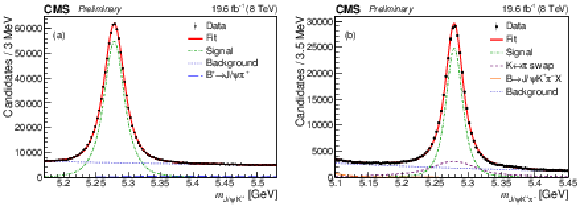
png pdf |
Figure 1:
Invariant mass distributions of J/ψK+ (a) and J/ψK+π− (b) candidates in the data with the fit results superimposed. |
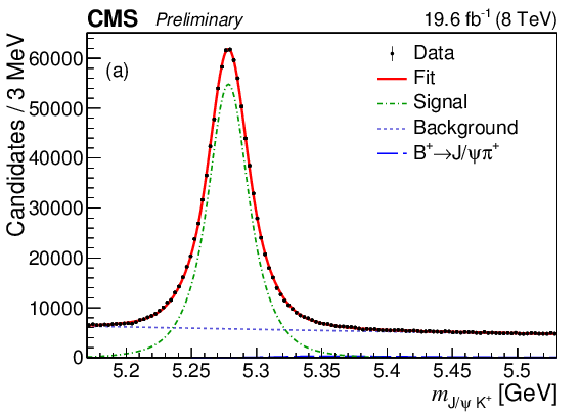
png pdf |
Figure 1-a:
Invariant mass distributions of J/ψK+ (a) and J/ψK+π− (b) candidates in the data with the fit results superimposed. |
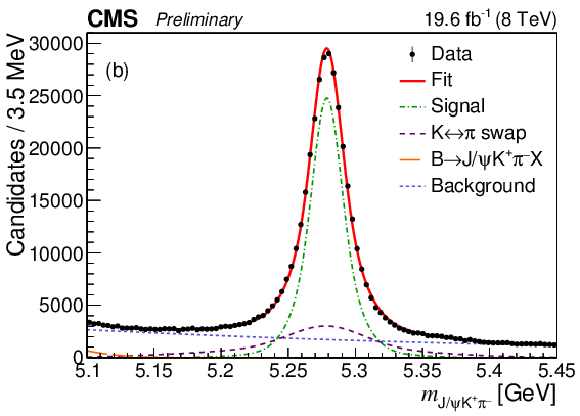
png pdf |
Figure 1-b:
Invariant mass distributions of J/ψK+ (a) and J/ψK+π− (b) candidates in the data with the fit results superimposed. |
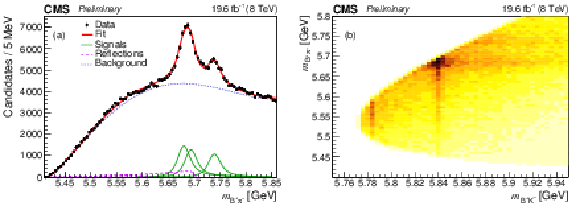
png pdf |
Figure 2:
(a) The fitted B+π− invariant mass distribution. The points represent the data, the thick solid curve is the fit projection, the thin lines indicate the excited B0 signal contributions, the dashed curve is the background, and the long-dashed lines show the contributions from the excited B0s decays. (b) Two-dimensional distribution of mB+K− versus mB+π− in data. |
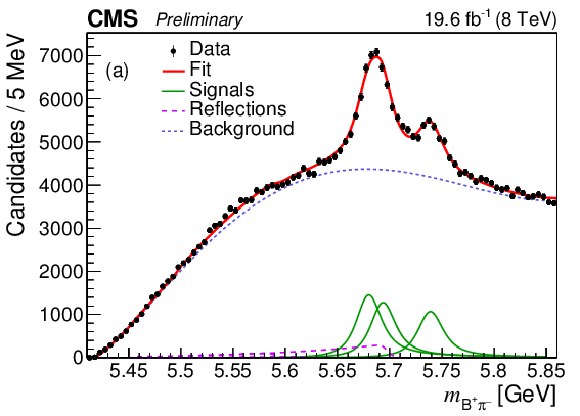
png pdf |
Figure 2-a:
(a) The fitted B+π− invariant mass distribution. The points represent the data, the thick solid curve is the fit projection, the thin lines indicate the excited B0 signal contributions, the dashed curve is the background, and the long-dashed lines show the contributions from the excited B0s decays. (b) Two-dimensional distribution of mB+K− versus mB+π− in data. |

png pdf |
Figure 2-b:
(a) The fitted B+π− invariant mass distribution. The points represent the data, the thick solid curve is the fit projection, the thin lines indicate the excited B0 signal contributions, the dashed curve is the background, and the long-dashed lines show the contributions from the excited B0s decays. (b) Two-dimensional distribution of mB+K− versus mB+π− in data. |

png pdf |
Figure 3:
Invariant mass distributions of B+K− (a) and B0K0S (b) candidates with the results of the fit overlaid. The points represent the data, the thick curves are the fit projections, the thin lines display the signal contributions, and the long-dashed lines show: in (a) the contributions from excited B0 meson decays; in (b) the contributions from K±↔π± swap in B0 reconstruction. The dashed lines show the background contribution. |
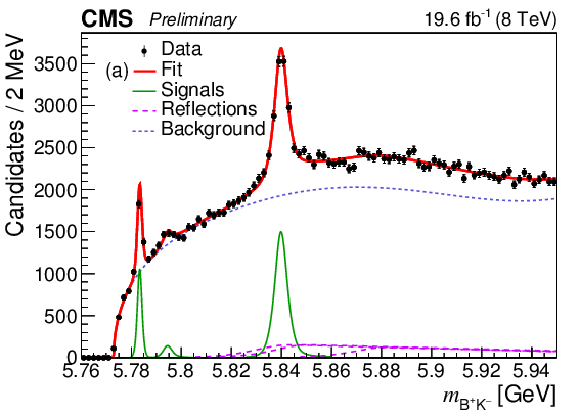
png pdf |
Figure 3-a:
Invariant mass distributions of B+K− (a) and B0K0S (b) candidates with the results of the fit overlaid. The points represent the data, the thick curves are the fit projections, the thin lines display the signal contributions, and the long-dashed lines show: in (a) the contributions from excited B0 meson decays; in (b) the contributions from K±↔π± swap in B0 reconstruction. The dashed lines show the background contribution. |
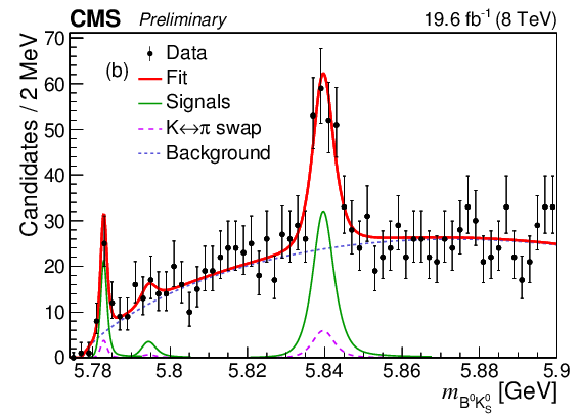
png pdf |
Figure 3-b:
Invariant mass distributions of B+K− (a) and B0K0S (b) candidates with the results of the fit overlaid. The points represent the data, the thick curves are the fit projections, the thin lines display the signal contributions, and the long-dashed lines show: in (a) the contributions from excited B0 meson decays; in (b) the contributions from K±↔π± swap in B0 reconstruction. The dashed lines show the background contribution. |
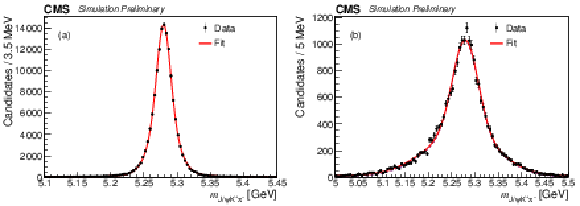
png pdf |
Figure 4:
mB0 distribution in simulation with the fit result superimposed. (a) signal with matching; (b) reflection from 'K±↔π± swap' obtained by requiring the reconstructed kaon candidate to be matched to the generated pion and vice versa. |
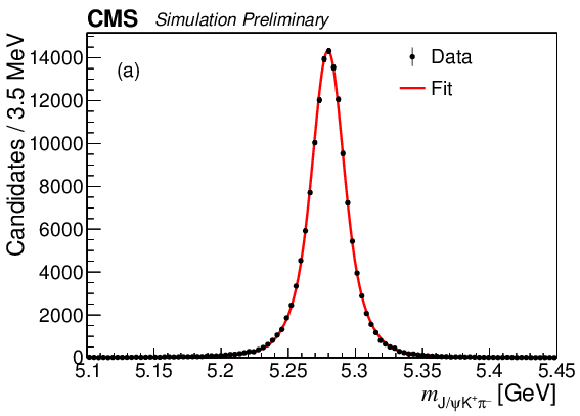
png pdf |
Figure 4-a:
mB0 distribution in simulation with the fit result superimposed. (a) signal with matching; (b) reflection from 'K±↔π± swap' obtained by requiring the reconstructed kaon candidate to be matched to the generated pion and vice versa. |
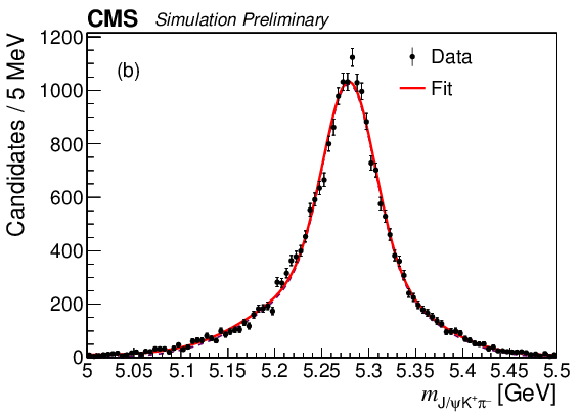
png pdf |
Figure 4-b:
mB0 distribution in simulation with the fit result superimposed. (a) signal with matching; (b) reflection from 'K±↔π± swap' obtained by requiring the reconstructed kaon candidate to be matched to the generated pion and vice versa. |
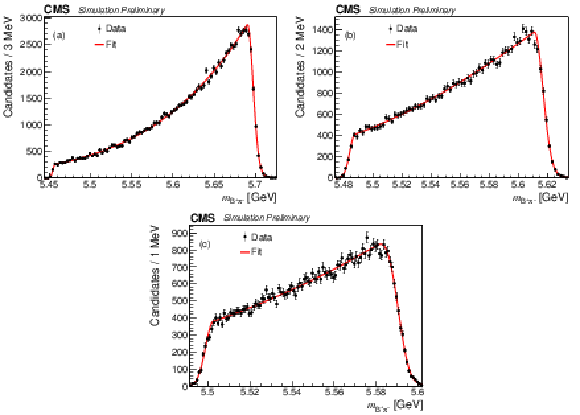
png pdf |
Figure 5:
The B+π− invariant mass distributions from the simulated decay: (a) B∗s2→B+K−; (b) B∗s2→B∗+K−; (c) Bs1→B∗+K−. |
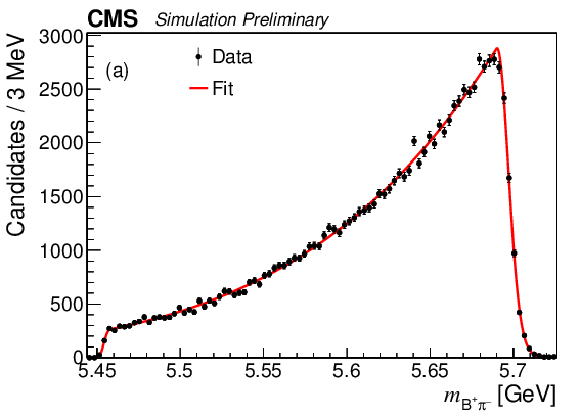
png pdf |
Figure 5-a:
The B+π− invariant mass distributions from the simulated decay: (a) B∗s2→B+K−; (b) B∗s2→B∗+K−; (c) Bs1→B∗+K−. |
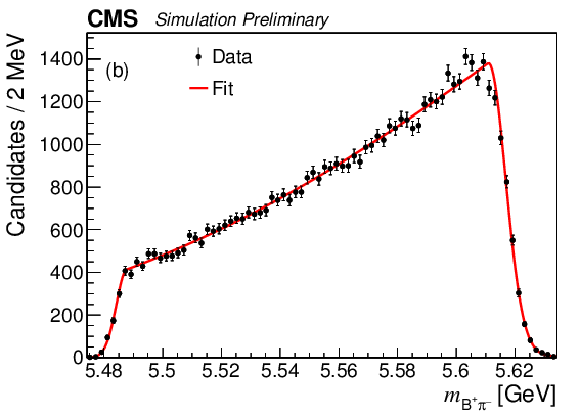
png pdf |
Figure 5-b:
The B+π− invariant mass distributions from the simulated decay: (a) B∗s2→B+K−; (b) B∗s2→B∗+K−; (c) Bs1→B∗+K−. |
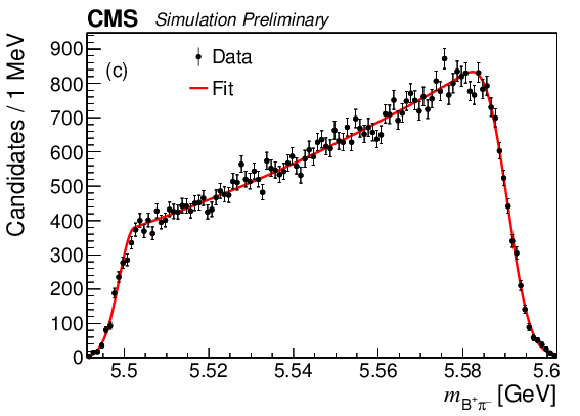
png pdf |
Figure 5-c:
The B+π− invariant mass distributions from the simulated decay: (a) B∗s2→B+K−; (b) B∗s2→B∗+K−; (c) Bs1→B∗+K−. |
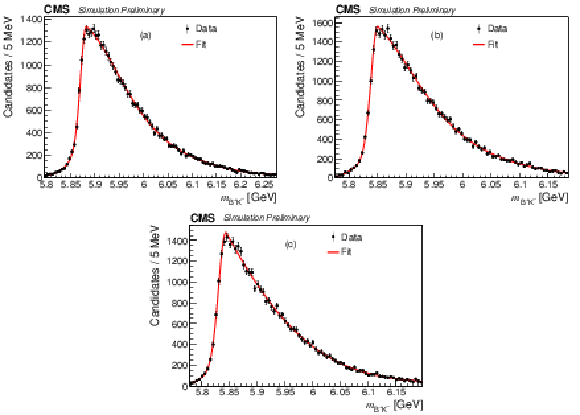
png pdf |
Figure 6:
The B+K− invariant mass distributions from the simulated decay: (a) B∗2→B+π−, (b) B∗2→B∗+π− and (c) B1→B∗+π−. |
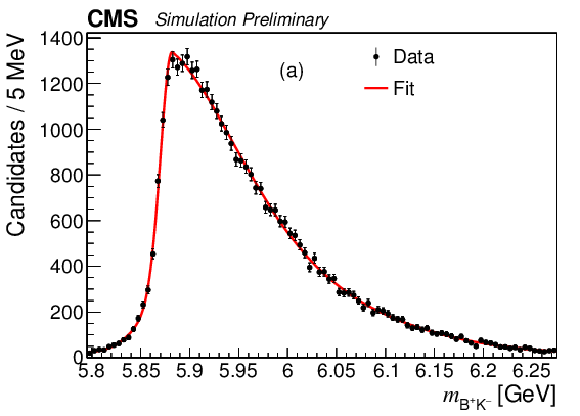
png pdf |
Figure 6-a:
The B+K− invariant mass distributions from the simulated decay: (a) B∗2→B+π−, (b) B∗2→B∗+π− and (c) B1→B∗+π−. |
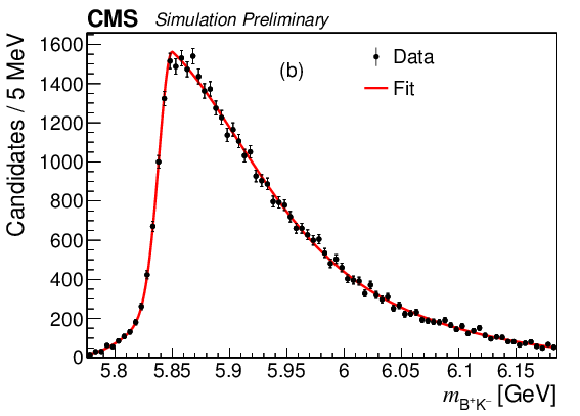
png pdf |
Figure 6-b:
The B+K− invariant mass distributions from the simulated decay: (a) B∗2→B+π−, (b) B∗2→B∗+π− and (c) B1→B∗+π−. |
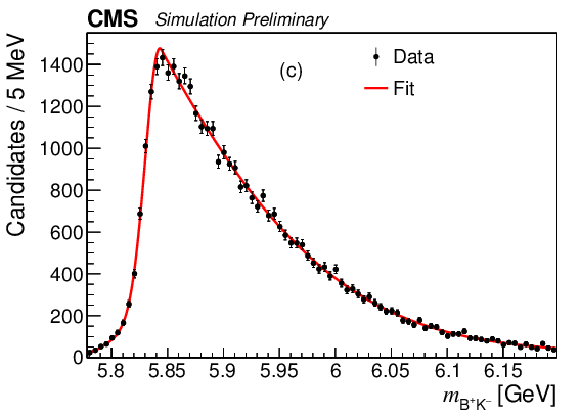
png pdf |
Figure 6-c:
The B+K− invariant mass distributions from the simulated decay: (a) B∗2→B+π−, (b) B∗2→B∗+π− and (c) B1→B∗+π−. |
| Tables | |

png pdf |
Table 1:
Results on B(∗)s1,2 from previous measurements. Mass differences are designated as ΔM±Bs1≡M(Bs1)−M(B∗+)−M(K−), ΔM±B∗s2≡M(B∗s2)−M(B+)−M(K−). |
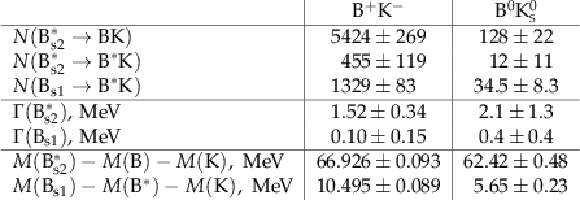
png pdf |
Table 2:
Results from the fits to the mBK distributions in data. |
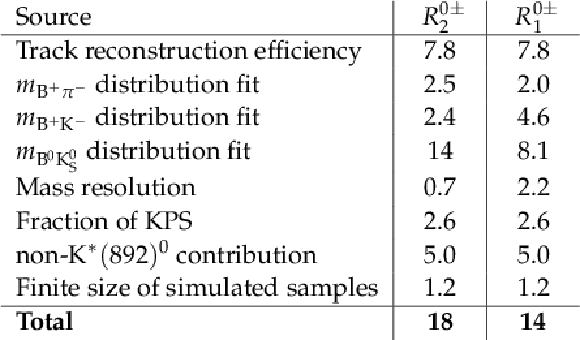
png pdf |
Table 3:
Systematic uncertainties in percent in the ratios R0±2 and R0±1. |
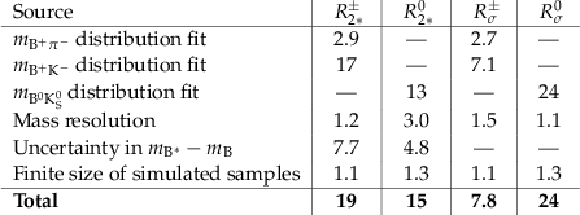
png pdf |
Table 4:
Systematic uncertainties (in%) in the ratios R±2∗, R02∗, R±σ, and R0σ. |

png pdf |
Table 5:
Systematic uncertainties (in MeV) in the measured mass differences and natural width (ΓB∗s2, measured only in B+K− channel). |
| Summary |
| In summary, the P-wave B0s meson states are studied using a data sample corresponding to an integrated luminosity of 19.6 fb−1 of pp collisions collected by the CMS experiment at √s= 8 TeV in 2012. The observation and the first evidence are reported for the decays B∗s2→B0K0S and Bs1→B∗0K0S, respectively. Four ratios of branching fractions and two ratios of cross section multiplied by the branching fractions of the P-wave B0s mesons into B meson and kaon are measured. In addition, the differences between the B(∗)s1,2 mass and the sum of B meson and kaon mass are determined, as well as the B(∗)s2 natural width. Finally, using a new approach, the mass differences mB0−mB+ and mB∗0−mB∗+ are measured, where the latter mass difference is measured for the first time. |
| References | ||||
| 1 | F. E. Close and Z.-p. Li | Effective heavy quark theory | PLB 289 (1992) 143 | hep-ph/9206217 |
| 2 | A. G. Grozin | Heavy quark effective theory | Springer Tracts Mod. Phys. 201 (2004) 1 | |
| 3 | CDF Collaboration | Observation of orbitally excited Bs mesons | PRL 100 (2008) 082001 | 0710.4199 |
| 4 | D0 Collaboration | Observation and properties of the orbitally excited B*(s2) meson | PRL 100 (2008) 082002 | 0711.0319 |
| 5 | LHCb Collaboration | First observation of the decay B∗s2(5840)0→B∗+K− and studies of excited B0s mesons | PRL 110 (2013) 151803 | 1211.5994 |
| 6 | CDF Collaboration | Study of orbitally excited B mesons and evidence for a new Bπ resonance | PRD 90 (2014) 012013 | 1309.5961 |
| 7 | CMS Collaboration | The CMS experiment at the CERN LHC | JINST 3 (2008) S08004 | CMS-00-001 |
| 8 | CMS Collaboration | Description and performance of track and primary-vertex reconstruction with the CMS tracker | JINST 9 (2014) P10009 | CMS-TRK-11-001 1405.6569 |
| 9 | CMS Collaboration | Performance of CMS muon reconstruction in pp collision events at √s= 7 TeV | JINST 7 (2012) P10002 | CMS-MUO-10-004 1206.4071 |
| 10 | CMS Collaboration | The CMS trigger system | JINST 12 (2017) P01020 | CMS-TRG-12-001 1609.02366 |
| 11 | CMS Collaboration | Measurement of the CP-violating weak phase ϕs and the decay width difference ΔΓs using the B0s→J/ψϕ(1020) decay channel in pp collisions at √s= 8 ~TeV | PLB 757 (2016) 97 | CMS-BPH-13-012 1507.07527 |
| 12 | CMS Collaboration | Search for the X(5568) state decaying into B0sπ± in proton-proton collisions at √s= 8 TeV | PRL 120 (2018) 202005 | CMS-BPH-16-002 1712.06144 |
| 13 | Particle Data Group, C. Patrignani et al. | Review of particle physics | CPC 40 (2016) 100001 | |
| 14 | T. Sjostrand, S. Mrenna, and P. Skands | PYTHIA 6.4 physics and manual | JHEP 05 (2006) 026 | hep-ph/0603175 |
| 15 | D. J. Lange | The EvtGen particle decay simulation package | NIMA 462 (2001) 152 | |
| 16 | E. Barberio, B. van Eijk, and Z. W\cas | PHOTOS --- a universal Monte Carlo for QED radiative corrections in decays | CPC 66 (1991) 115 | |
| 17 | E. Barberio and Z. W\cas | PHOTOS -- a universal Monte Carlo for QED radiative corrections: version 2.0 | CPC 79 (1994) 291 | |
| 18 | GEANT4 Collaboration | GEANT4---a simulation toolkit | NIMA 506 (2003) 250 | |
| 19 | M. Pivk and F. R. Le Diberder | sPlot: a statistical tool to unfold data distributions | NIMA 555 (2005) 356--369 | physics/0402083 |
| 20 | CMS Collaboration | Alignment of the CMS tracker with LHC and cosmic ray data | JINST 9 (2014) P06009 | CMS-TRK-11-002 1403.2286 |
| 21 | Z.-H. Wang, G.-L. Wang, H.-F. Fu, and Y. Jiang | The strong decays of orbitally excited B∗sJ mesons by improved Bethe-Salpeter method | PLB 706 (2012) 389 | 1202.1224 |
| 22 | Q.-F. Lu et al. | Excited bottom and bottom-strange mesons in the quark model | PRD 94 (2016) 074012 | 1607.02812 |
| 23 | X.-h. Zhong and Q. Zhao | Strong decays of heavy-light mesons in a chiral quark model | PRD 78 (2008) 014029 | 0803.2102 |
| 24 | P. Colangelo, F. De Fazio, F. Giannuzzi, and S. Nicotri | New meson spectroscopy with open charm and beauty | PRD 86 (2012) 054024 | 1207.6940 |

|
Compact Muon Solenoid LHC, CERN |

|

|

|

|

|

|